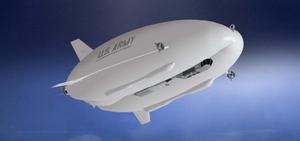BlimpsU.S. Army's new surveillance blimp will fly "mid-next summer"
Northrop Grumman successfully completed another test of the Long Endurance Multi-intelligence Vehicle (LEMV) — a blimp longer than a football field and taller than a seven-story building, which will remain airborne for more than three weeks at a time, carrying multiple surveillance payloads

Artist rendering of the LEMV airship in flight // Source: Northrop Grumman Aerospace Systems
The U.S. Army’s plan to build an optionally crewed airship with the aid of British designers is going well, according to the ship’s builders.
Northrop Grumman, contracted to deliver the Long Endurance Multi-intelligence Vehicle (LEMV) ship to the U.S. Army Space and Missile Defense Command, says that the ship has “completed three important program milestones” — reviews of the project’s feasibility before manufacturing begins — and it is on track for first flight in “mid-next summer.”
The LEMV is intended to cruise the skies above Afghanistan carrying multiple surveillance payloads at 20,000 foot altitude for up to three weeks at a time. It will normally be unmanned in operation, but will be able to carry a human crew when required — for instance, while transiting through civil controlled airspace en route to and from the war zone.
“LEMV is longer than a football field, taller than a seven-story building and will remain airborne for more than three weeks at a time, delivering a high level of fuel efficiency. Fuel costs are minimal at $11,000 for a 21-day period of service. It’s very green,” says Alan Metzger, vice president and integrated program team leader of LEMV and airship programs.
Lewis Page writes that the LEMV airship is based on British firm Hybrid Air Vehicles’ HAV30 design. It is designed to take off in a heavier-than-air condition aided by vectored thrust from its propellers, and maintain lift in the cruise aided by dynamic lift from forward flight as well as buoyancy from the helium in the envelope. This means that the ship will not become lighter-than-air as its fuel is burned up, and it will be able to land without needing to vent off expensive gas.
The $517 million LEMV deal will see “up to three” LEMV ships built for the U.S. Army. The project is the largest airship effort — in terms of both ship size and money — currently underway. The LEMV, however, once flying, will be rather small compared to the rigid airships of the pre-Second World War era. The last of them, LZ-129 Hindenburg, which was destroyed at the Lakehurst disaster, was 800 feet long.
